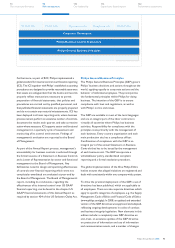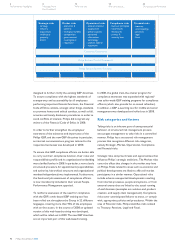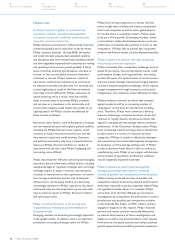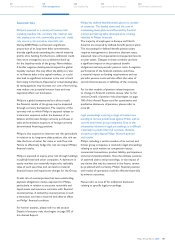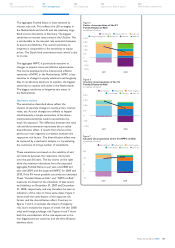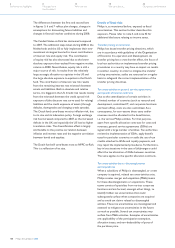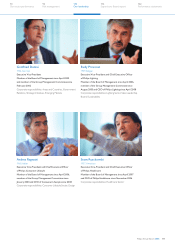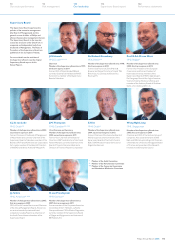Philips 2008 Annual Report Download - page 103
Download and view the complete annual report
Please find page 103 of the 2008 Philips annual report below. You can navigate through the pages in the report by either clicking on the pages listed below, or by using the keyword search tool below to find specific information within the annual report.
Philips does not hedge the translation exposure of net
income in foreign entities.
Foreign exchange exposure also arises as a result of
inter-company loans and deposits. Where the Company
enters into such arrangements the financing is
generally provided in the functional currency of the
subsidiary entity. The currency of the Company’s
external funding and liquid assets is matched with
the required financing of subsidiaries either directly
through external foreign currency loans and deposits,
or synthetically by using foreign exchange derivatives.
In certain cases where group companies may also have
external foreign currency debt or liquid assets, these
exposures are also hedged through the use of foreign
exchange derivatives. Changes in the fair value of
hedges related to this translation exposure are
recognized within financial income and expenses in
the income statement and are largely offset by the
revaluation of the hedged items. The total net fair
value of these derivatives as of December 31, 2008,
was an unrealized loss of EUR 216 million. An
instantaneous 10% increase in the value of the euro
against all currencies would lead to an increase in the
value of the derivatives of EUR 339 million, including
a EUR 318 million increase due to the US dollar.
Translation exposure of equity invested in consolidated
foreign entities is partially hedged. If a hedge is entered
into, it is accounted for as a net investment hedge.
As at December 31, 2008, Philips had no outstanding
derivatives accounted for as net investment hedges.
During 2008, Philips recorded a gain of EUR 11 million
in other comprehensive income under currency
translation differences as a result of net
investment hedges.
a function of the ability to forecast cash flows and
the way in which the businesses can adapt to changed
levels of foreign-currency exchange rates. As a result,
hedging activities may not eliminate all currency risks
for these transaction exposures. Generally, the
maximum tenor of these hedges is 18 months.
The table on the opposite page outlines the estimated
nominal value in millions of euros for transaction
exposure and related hedges for Philips’ most significant
currency exposures as of December 31, 2008. The
derivatives related to transactions are, for hedge
accounting purposes, split into hedges of on-balance-
sheet accounts receivable/payable and forecasted sales
and purchases. Changes in the value of on-balance-
sheet foreign-currency accounts receivable/payable,
as well as the changes in the fair value of the hedges
related to these exposures, are reported in the income
statement under cost of sales. Hedges related to
forecasted transactions are accounted for as cash flow
hedges. The results from such hedges are deferred
in other comprehensive income within equity to the
extent that the hedge is effective. Currently, a loss
of EUR 17 million is deferred in equity as a result of
these hedges. The result deferred in equity will mostly
be released to earnings during 2009 at the time when
the related hedged transactions affect the income
statement. During 2008, a net loss of EUR 3 million
was recorded in the income statement as a result of
ineffectiveness of transaction hedges.
The total net fair value of hedges related to transaction
exposure as of December 31, 2008 was an unrealized
loss of EUR 21 million. An instantaneous 10% increase
in the value of the euro against all currencies would lead
to an increase in the value of the derivatives of EUR 26
million, including a EUR 12 million increase related to
deals of the euro against the pound sterling, a EUR 10
million increase related to deals of the euro against
the Japanese yen and a EUR 3 million increase related
to deals of the euro against the US dollar. This EUR 26
million includes a loss of EUR 11 million that would
impact the income statement, which is offset by an
equal and opposite effect on the underlying accounts
receivable and payable, and a gain of EUR 37 million
that would be recognized in equity to the extent that
the cash flow hedges are effective. The net change
in value in other derivatives would be an increase of
EUR 1 million.
The change in fair value of the hedges of transactions
in the case of a 10% appreciation in the euro for deals
of the euro against the US dollar and the euro against
the pound sterling has been further broken down in
the above tables.
Sensitivity to a 10% increase in euro versus USD
in millions of euros
maturity 0-12
months
maturity > 12
months
Change in fair value of forwards −2
Change in fair value of options 1 −
Sensitivity to a 10% increase in euro versus GBP
in millions of euros
maturity 0-12
months
maturity > 12
months
Change in fair value of forwards 11 1
Philips Annual Report 2008 103
122
Performance statements
114
Supervisory Board report
110
Our leadership
94
Risk management
70
Our sector performance




